Despite the biggest natural disasters recorded in 2016 and the deadliest terror attacks in Europe, the percentage of those engaging in international travel is still growing and the anticipation of further growth is high. According to ITB World Travel Trends Report, the overall volume of world travel was impacted by neither terrorism nor political unrest, and the number of international trips is expected to increase 4-5 percent in 2017.
Regardless of the security challenges, the travel industry continues its rapid technological development, which shapes the experiences of each global traveler.
We’ve already talked about how data science is impacting the travel industry. So, let's discuss the main travel tech trends for 2017.
Many people are captivated by the idea of traveling the world without leaving the house. With the right wearable on hand, you can be completely immersed in a thrilling journey. Sometimes, VR also plays an important role in the decision-making process – once an armchair traveler gets the first taste of an upcoming adventure, booking it becomes irresistible.
According to YouVist and analytics, more than 13 percent of those who took a VR tour of a destination took further steps in actual trip planning. For instance, the series of interactive VR content produced for the brand Visit Houston can inspire customers to buy tickets for events and things to do in Houston.
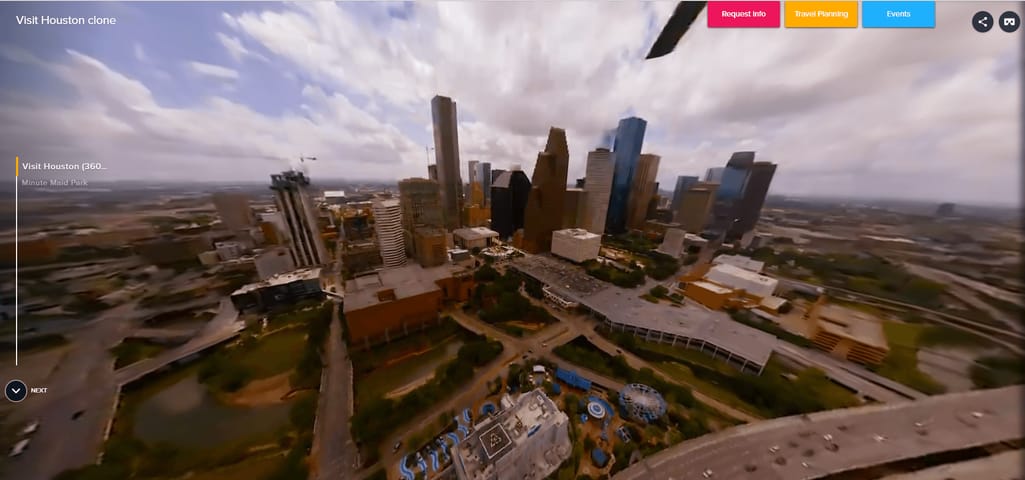 Carnival, a cruise brand, offers a complete overview of their cruise ships by showcasing a deck, available suites, lounge, sport, and water facilities. Such VR tours allow passengers to get familiar with all conveniences and buy a cruise deal without wondering about comforts on the ship.
Carnival, a cruise brand, offers a complete overview of their cruise ships by showcasing a deck, available suites, lounge, sport, and water facilities. Such VR tours allow passengers to get familiar with all conveniences and buy a cruise deal without wondering about comforts on the ship.
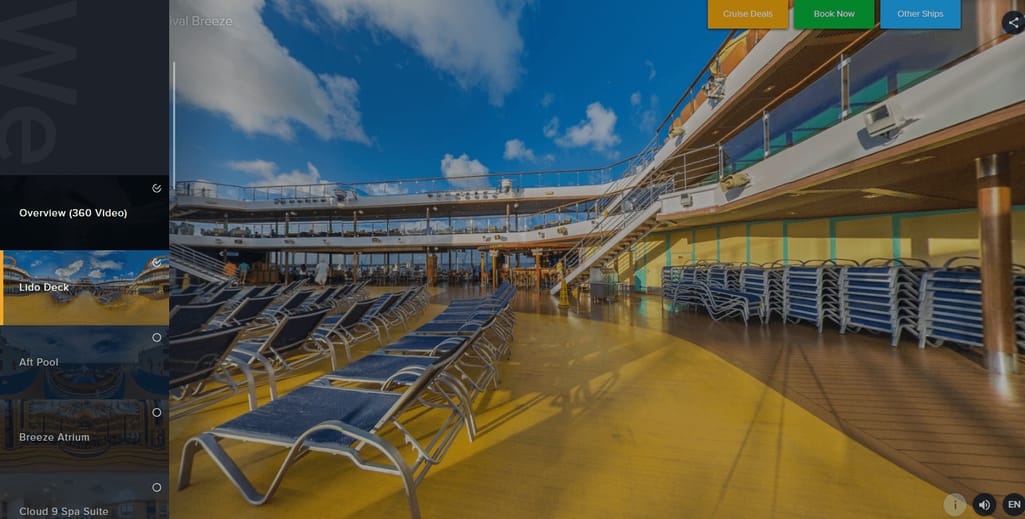
Due to the price factor of required wearables, VR tours are still conquering their segment while 360-videos have already been adopted by many hospitality businesses. A 360-tour is a cheap and easy way to provide people with the VR-like experience.
Two-dimensional photographs are replaced by 360-degree videos or tours through hotel amenities. For instance, Trump International Hotel & Tower invites guests to take a panoramic, virtual walk inside Trump Chicago navigating the rooms, dining facilities, spa, and main areas. Such tours allow customers to make the right choice on the category of room to book and the restaurant table to reserve.
There’s another important use case for 360-tours. Have you ever experienced the anxiety of getting lost in a crowded public place? One can easily have a panic attack after being caught in Heathrow Airport, the busiest airport in the world, which in 2016 handled a record 75.7 million passengers. Major airports can become more passenger-friendly by launching 360-tour guides. The Munich airport, Munich Airport Center (MAC), the seventh busiest airport in Europe, has been offering this innovative service since last year. All of MAC can be accessed online. A 360-tour is a perfect way for a passenger to become familiar with an airport before leaving home to avoid any complications once there.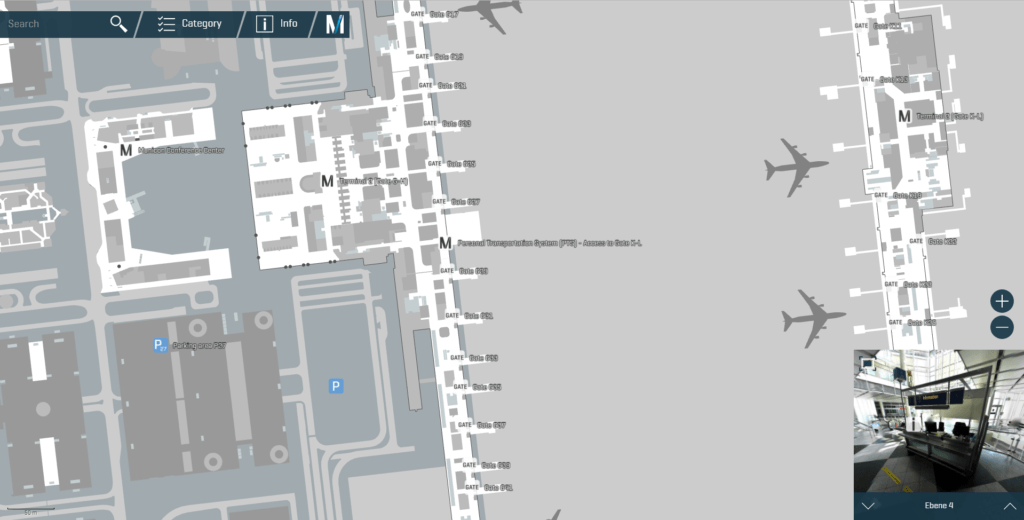 So, there are clear benefits to 360-degree videos and images that allow for early engagement of potential customers while VR is yet to reveal its broad opportunities. The current problem with VR is the lack of devices on hand and high prices for top headsets like Oculus Rift and HTC Vive. But it seems that VR is going to eventually replace 360 videos and tours, once the technology reaches mass adoption.
So, there are clear benefits to 360-degree videos and images that allow for early engagement of potential customers while VR is yet to reveal its broad opportunities. The current problem with VR is the lack of devices on hand and high prices for top headsets like Oculus Rift and HTC Vive. But it seems that VR is going to eventually replace 360 videos and tours, once the technology reaches mass adoption.
The first hotel that's announced its move towards virtual assistants is Wynn Las Vegas. They plan to equip more than 4,700 rooms with Amazon Alexa. The installation, which started with suites, is planned to be completed by summer 2017. Steve Wynn, CEO of Wynn Resorts Limited, speaks glowingly about how Alexa can become the ultimate 24-hour butler at each guest's beck and call.
Marriott International is currently testing Alexa and Siri at its Aloft hotel in Boston’s Seaport District. Bloomberg reports that by the summer the decision will be made whether or not one or more of its properties will adopt the technology. If the new technology is to be adopted, the decision between the two AI devices will follow.
It is anticipated that other hotel chains will integrate AI devices into their rooms as well. Moreover, Mehmet Erdem, a hospitality scholar at UNLV and president of the iHITA, predicts that technology like Amazon Alexa will soon become an affordable, normalized household item expected in any hotel.
For instance, TripHobo is a free trip planning automation tool that enables users to plan journeys that meet their budgets. A user defines a trip budget and destination. Then the system in a semi-automatic mode sets the plan that includes flights, accommodations, activities, and even restaurants to visit according to the set budget. Also, a traveler can customize the plan by including or removing hotels, attractions, and events. Another useful feature of TripHobo is saving and sharing your trip route on social media with friends. It’s very handy as the itineraries are already tested and serve as good guides for other travelers. Currently, the service covers over 14,000 cities across the world.
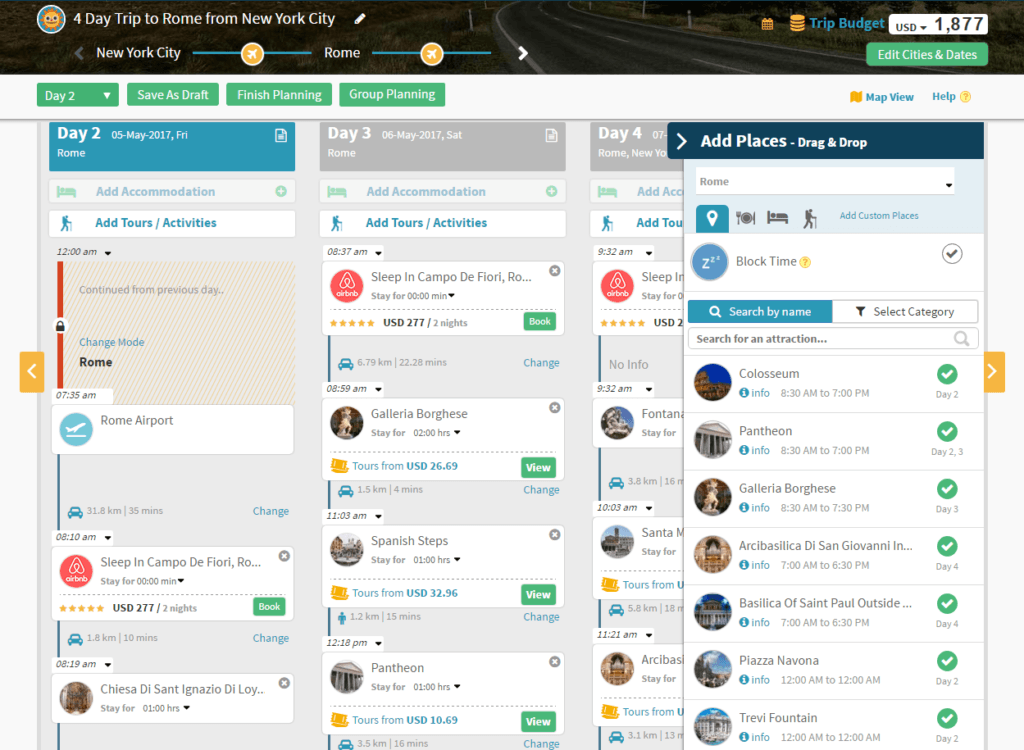
Eightydays, a Belarusian progressive startup founded in 2015, is a multi-city adventure designer. This platform offers to build travel routes across Europe by asking simple questions such as travel dates and start and finish destinations (for now, it is necessary to start and end the trip in the same place). Users can also select if they want to look at cities in Europe, the European Union, or just the Schengen Zone. By processing all information, it lays out four different itineraries visiting 2, 3, 4, or 5 cities during European vacations.
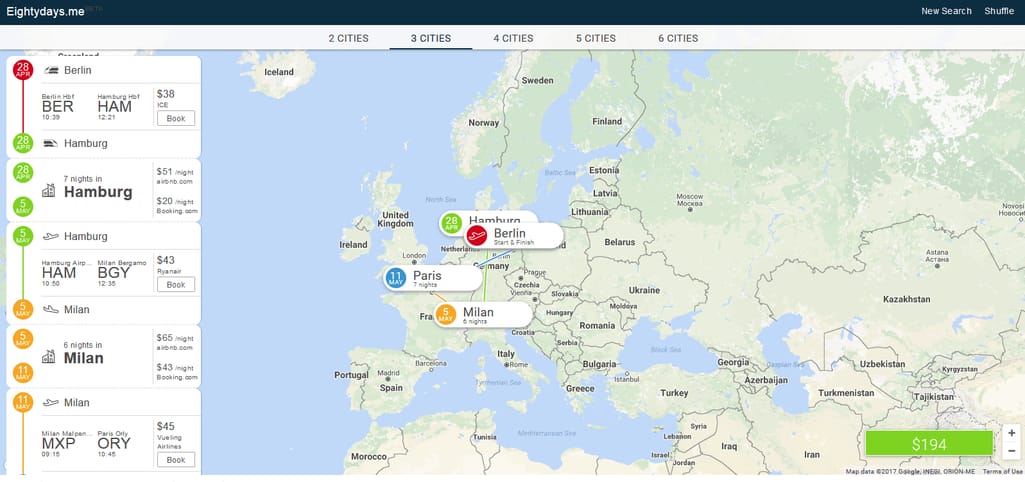
While not yet a perfect system for booking an entire trip, Eightydays supplies valuable travel hints and understanding about pricing.
Another feature in complex trip-planning worth mentioning is Airbnb Experiences that have been launched in 12 major cities worldwide so far. Experiences are activities – varying from cycling tours and food testing to learning aerial photography – handcrafted by local hosts. Experiences is meant to immerse newcomers in neighborhoods and generally give them a local's eye view at the destination they visit. It’s not only travelers who benefit from the experiences, but also hosts who provide these activities as well. Chip Conley, Airbnb strategic advisor for hospitality and leadership, sees being a host as a job option for young people: “To imagine someone as an 18-year-old, and say, ‘What do you want to do when you grow up?’ ‘I want to be a host.’”
Besides, traditional word-for-word translation, there are a number of distinct translation features provided by several services, which help travelers overcome the language barrier. The main features common for these apps and services are offline translation, voice mode, website translation, and conjugations.
Voice mode. It's amazing that real-time translation is now possible without a human interpreter. This feature allows users to say a sentence that is instantly transformed into spoken words or shown on a smartphone screen text. For example, SayHi Translate connects people communicating in their native languages and having a real-time translated conversation.
Offline translation. Nine out of 10 Europeans who travel outside their home country limit their use of mobile services because of roaming charges. So, offline translation support is very valuable. Bing Translator and Google Translate allow downloading languages to translate offline.
Website translation. Google Translate makes any website instantly available in more than 100 languages if you use Chrome.
Verb conjugations. It's important to keep the same tense and mood of verbs while translating. If correct verb conjugation is maintained, the translation is appropriate and of high quality. This is why, in addition to straightforward translations, the iTranslate app offers conjugation tables to help learners use verbs in their correct form.
Currently, not many vendors combine all these features and offer accurate translation to the full extent. So, there’s room for further development.
In 1999, Disneyland Resort and Walt Disney World first introduced Disney FASTPASS. On the idea of a paper ticket, FASTPASS assigns a specific time to enter the attraction, a so-called virtual queue. At the end of 2013, the system was upgraded to include FastPass+ allowing guests to reserve and plan a visit to a Disney park up to 60 days in advance for selected FastPass+ attractions, Character Greetings, entertainment, and viewing areas for parades and fireworks. January 2017 heralded another change. the launch of the new Disney MaxPass was announced. MaxPass is a system which allows the use of the Disneyland FASTPASS system digitally through the Disneyland App. Guests will be able to book FASTPASSES on their smartphones anywhere throughout the park. The new Disney MaxPass will cost $10 per ticket per day, which includes PhotoPass, a photography service.
There are two distinct trends in the travel industry. The first one entails customer engagement even before a traveler reaches a destination. For instance, virtual reality and 360-tours are powerful means to introduce future experiences and increase chances that a person will eventually purchase tickets or book a room.
Another major trend is booking and trip planning automation provided by middleware services. A large segment of travelers is looking for low airfares and affordable accommodations. It takes experience to plan a trip that meets both a limited budget and a certain level of comfort. Trip planning services may automate travel agency layer and provide an unbiased view on many destinations with affordable prices. Of course, if you want to know more about what’s happening in the digital world, check our news and trends story for March 2017.
Regardless of the security challenges, the travel industry continues its rapid technological development, which shapes the experiences of each global traveler.
We’ve already talked about how data science is impacting the travel industry. So, let's discuss the main travel tech trends for 2017.
1. Virtual reality and virtual tours (360-tours)
Virtual reality has been much discussed. It's one of the showiest innovations affecting the travel industry. Though not yet a mainstay, VR's vast potential is intriguing.Many people are captivated by the idea of traveling the world without leaving the house. With the right wearable on hand, you can be completely immersed in a thrilling journey. Sometimes, VR also plays an important role in the decision-making process – once an armchair traveler gets the first taste of an upcoming adventure, booking it becomes irresistible.
According to YouVist and analytics, more than 13 percent of those who took a VR tour of a destination took further steps in actual trip planning. For instance, the series of interactive VR content produced for the brand Visit Houston can inspire customers to buy tickets for events and things to do in Houston.
 Carnival, a cruise brand, offers a complete overview of their cruise ships by showcasing a deck, available suites, lounge, sport, and water facilities. Such VR tours allow passengers to get familiar with all conveniences and buy a cruise deal without wondering about comforts on the ship.
Carnival, a cruise brand, offers a complete overview of their cruise ships by showcasing a deck, available suites, lounge, sport, and water facilities. Such VR tours allow passengers to get familiar with all conveniences and buy a cruise deal without wondering about comforts on the ship.
Due to the price factor of required wearables, VR tours are still conquering their segment while 360-videos have already been adopted by many hospitality businesses. A 360-tour is a cheap and easy way to provide people with the VR-like experience.
Two-dimensional photographs are replaced by 360-degree videos or tours through hotel amenities. For instance, Trump International Hotel & Tower invites guests to take a panoramic, virtual walk inside Trump Chicago navigating the rooms, dining facilities, spa, and main areas. Such tours allow customers to make the right choice on the category of room to book and the restaurant table to reserve.
There’s another important use case for 360-tours. Have you ever experienced the anxiety of getting lost in a crowded public place? One can easily have a panic attack after being caught in Heathrow Airport, the busiest airport in the world, which in 2016 handled a record 75.7 million passengers. Major airports can become more passenger-friendly by launching 360-tour guides. The Munich airport, Munich Airport Center (MAC), the seventh busiest airport in Europe, has been offering this innovative service since last year. All of MAC can be accessed online. A 360-tour is a perfect way for a passenger to become familiar with an airport before leaving home to avoid any complications once there.
 So, there are clear benefits to 360-degree videos and images that allow for early engagement of potential customers while VR is yet to reveal its broad opportunities. The current problem with VR is the lack of devices on hand and high prices for top headsets like Oculus Rift and HTC Vive. But it seems that VR is going to eventually replace 360 videos and tours, once the technology reaches mass adoption.
So, there are clear benefits to 360-degree videos and images that allow for early engagement of potential customers while VR is yet to reveal its broad opportunities. The current problem with VR is the lack of devices on hand and high prices for top headsets like Oculus Rift and HTC Vive. But it seems that VR is going to eventually replace 360 videos and tours, once the technology reaches mass adoption.
2. Virtual assistants in hospitality
All hoteliers strive to stand out from the crowd with unique, personalized services. Virtual assistants have increased guest comfort level. Voice-activated assistants control the guest's surroundings providing services such as introduction to room amenities, setting an alarm clock, helping with navigation around the property, requesting room services and beverages, switching on music, lights, television, or changing room temperature on demand.The first hotel that's announced its move towards virtual assistants is Wynn Las Vegas. They plan to equip more than 4,700 rooms with Amazon Alexa. The installation, which started with suites, is planned to be completed by summer 2017. Steve Wynn, CEO of Wynn Resorts Limited, speaks glowingly about how Alexa can become the ultimate 24-hour butler at each guest's beck and call.
Marriott International is currently testing Alexa and Siri at its Aloft hotel in Boston’s Seaport District. Bloomberg reports that by the summer the decision will be made whether or not one or more of its properties will adopt the technology. If the new technology is to be adopted, the decision between the two AI devices will follow.
It is anticipated that other hotel chains will integrate AI devices into their rooms as well. Moreover, Mehmet Erdem, a hospitality scholar at UNLV and president of the iHITA, predicts that technology like Amazon Alexa will soon become an affordable, normalized household item expected in any hotel.
3. Complex trip planning
There are five major steps in trip organization: choose a destination, search and book flights, book accommodations, take care of local transportation, and, last but not least, plan things to see and to do. A majority of global travelers now prefer planning everything online. And a big range of trip-planning platforms have emerged to serve the niche. Most of them help with some specific steps, like finding accommodations or tickets with the lowest fares, e.g. Fareboom, just one AltexSoft's successful travel client project. But recently, advanced planning services have been introduced to the market. These revolve around setting the whole trip arrangement beforehand to save time and money.For instance, TripHobo is a free trip planning automation tool that enables users to plan journeys that meet their budgets. A user defines a trip budget and destination. Then the system in a semi-automatic mode sets the plan that includes flights, accommodations, activities, and even restaurants to visit according to the set budget. Also, a traveler can customize the plan by including or removing hotels, attractions, and events. Another useful feature of TripHobo is saving and sharing your trip route on social media with friends. It’s very handy as the itineraries are already tested and serve as good guides for other travelers. Currently, the service covers over 14,000 cities across the world.

Eightydays, a Belarusian progressive startup founded in 2015, is a multi-city adventure designer. This platform offers to build travel routes across Europe by asking simple questions such as travel dates and start and finish destinations (for now, it is necessary to start and end the trip in the same place). Users can also select if they want to look at cities in Europe, the European Union, or just the Schengen Zone. By processing all information, it lays out four different itineraries visiting 2, 3, 4, or 5 cities during European vacations.

While not yet a perfect system for booking an entire trip, Eightydays supplies valuable travel hints and understanding about pricing.
Another feature in complex trip-planning worth mentioning is Airbnb Experiences that have been launched in 12 major cities worldwide so far. Experiences are activities – varying from cycling tours and food testing to learning aerial photography – handcrafted by local hosts. Experiences is meant to immerse newcomers in neighborhoods and generally give them a local's eye view at the destination they visit. It’s not only travelers who benefit from the experiences, but also hosts who provide these activities as well. Chip Conley, Airbnb strategic advisor for hospitality and leadership, sees being a host as a job option for young people: “To imagine someone as an 18-year-old, and say, ‘What do you want to do when you grow up?’ ‘I want to be a host.’”
4. Translation Apps
If you take a vacation or go on a business trip, it’s always helpful to know some phrases from the local language. By doing this, you will reap locals' respect and appreciation. Knowing only a few phrases won't allow you to fully express yourself. That's where the translation apps come into play as they mitigate communication difficulties.Besides, traditional word-for-word translation, there are a number of distinct translation features provided by several services, which help travelers overcome the language barrier. The main features common for these apps and services are offline translation, voice mode, website translation, and conjugations.
Voice mode. It's amazing that real-time translation is now possible without a human interpreter. This feature allows users to say a sentence that is instantly transformed into spoken words or shown on a smartphone screen text. For example, SayHi Translate connects people communicating in their native languages and having a real-time translated conversation.
Offline translation. Nine out of 10 Europeans who travel outside their home country limit their use of mobile services because of roaming charges. So, offline translation support is very valuable. Bing Translator and Google Translate allow downloading languages to translate offline.
Website translation. Google Translate makes any website instantly available in more than 100 languages if you use Chrome.
Verb conjugations. It's important to keep the same tense and mood of verbs while translating. If correct verb conjugation is maintained, the translation is appropriate and of high quality. This is why, in addition to straightforward translations, the iTranslate app offers conjugation tables to help learners use verbs in their correct form.
Currently, not many vendors combine all these features and offer accurate translation to the full extent. So, there’s room for further development.
5. Attraction bookings go digital
People have been enjoying the convenience of online hotel and flight bookings for about 20 years. In 2017, booking attractions has become a new trend. Most traditional activities such as visiting museums, restaurants, and amusement parks have successfully gone digital to reach new customers. For instance, Smart Destinations promotes multi-attraction passes, Go Cards, for the top 12 US cities. Attractions are combined into packages of three types: all-inclusive, explorer, and build your own. By selecting a pass for the number of days, it’s possible to visit as many of the included attractions as one wishes each day. It’s activated at the first visit and remains valid for a predetermined number of consecutive calendar days. After check-out, the user receives a digital pass by email which can be printed out in advance or displayed right on the mobile device. The pass comes with a convenient online guidebook. By purchasing the Go Card, the tourist can cut costs by 25 to 55 percent.In 1999, Disneyland Resort and Walt Disney World first introduced Disney FASTPASS. On the idea of a paper ticket, FASTPASS assigns a specific time to enter the attraction, a so-called virtual queue. At the end of 2013, the system was upgraded to include FastPass+ allowing guests to reserve and plan a visit to a Disney park up to 60 days in advance for selected FastPass+ attractions, Character Greetings, entertainment, and viewing areas for parades and fireworks. January 2017 heralded another change. the launch of the new Disney MaxPass was announced. MaxPass is a system which allows the use of the Disneyland FASTPASS system digitally through the Disneyland App. Guests will be able to book FASTPASSES on their smartphones anywhere throughout the park. The new Disney MaxPass will cost $10 per ticket per day, which includes PhotoPass, a photography service.
The main changes to look at
It's amazing how rapidly technologies reshape travelling as we know it. Some of the mentioned tech trends are still developing and only hinting at great possibilities that they may bring, VR being an obvious example. However, as a tech consultant for travel businesses, we believe that most described opportunities can be realized now.There are two distinct trends in the travel industry. The first one entails customer engagement even before a traveler reaches a destination. For instance, virtual reality and 360-tours are powerful means to introduce future experiences and increase chances that a person will eventually purchase tickets or book a room.
Another major trend is booking and trip planning automation provided by middleware services. A large segment of travelers is looking for low airfares and affordable accommodations. It takes experience to plan a trip that meets both a limited budget and a certain level of comfort. Trip planning services may automate travel agency layer and provide an unbiased view on many destinations with affordable prices. Of course, if you want to know more about what’s happening in the digital world, check our news and trends story for March 2017.

Maryna is a passionate writer with a talent for simplifying complex topics for readers of all backgrounds. With 7 years of experience writing about travel technology, she is well-versed in the field. Outside of her professional writing, she enjoys reading, video games, and fashion.
Want to write an article for our blog? Read our requirements and guidelines to become a contributor.

